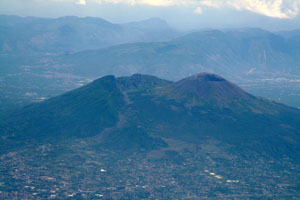The city of Pompeii was a bad place to be on August 24 in the year 79 AD. Things started out pleasantly enough, with the citizens of this Roman city of 20,000 going about their business as usual. Establishments such as bakeries and restaurants were serving their customers, and carts wheeled up and down the paved streets, making their deliveries. Other businesses, such as public baths and brothels, were also supplying their popular services. Around the city, repairs were still ongoing from a devastating earthquake which had struck the area seventeen years earlier. But there was light at the end of the tunnel, and many of the industrious residents had even found the time to decorate their homes with colorful paintings and mosaics. But then the mountain blew up.
Mt. Vesuvius, located a short distance to the northwest of Pompeii, is now known to be a volcano of frightening potential. It is considered to be the only active volcano on the European continent (two other active European volcanoes, Etna and Stromboli, are on islands). All three volcanoes were formed hundreds of thousands of years ago as a result of the subduction of the African tectonic plate beneath the Eurasian tectonic plate. Vesuvius has been erupting off and on for several thousand years, but it had been quiet for hundreds of years before 79 AD, apparently pausing to build up pressure. But because of this prolonged period of inactivity, Vesuvius was not generally considered to be anything other than a garden-variety 6500-foot mountain, though it did have some remarkably fertile soil on its slopes.
So one can easily imagine profound surprise among the Pompeiians in the early afternoon of August 24 when a humongous blast was followed by the appearance of a thick column of ash, pumice and other volcanic debris rising several miles into the sky. Unfortunately for Pompeii, the prevailing winds in the area blow toward the southeast, and August 24 was not atypical in this respect. So when gravity took over and the material blown skyward began to fall earthward, it did not land on Naples, which was about the same distance from the mountain but to its northwest, but instead started falling onto communities to the southeast. Like mainly Pompeii. To the unfortunate people in this afflicted town, this meant the blotting out of the sun and the beginning of a continuous snowstorm of choking dust. The dust was really pumice, and unlike snow, it was not going to melt and go away, in warm weather or at any other time – it just accumulated, and quickly. Roofs began to collapse under the weight, and Pompeii was being buried. This layer of pumice would eventually exceed ten feet in thickness. Most Pompeiians took the hint, scraped together some belongings and began to leave the city. But for reasons of their own, there were some who did not leave.
A pyroclastic flow can occur when the pressure of an eruption abates somewhat, and the superheated, poisonous gases coming from the volcano can no longer be blown very far upward. This leads to great clouds of volcanic material travelling rapidly down the sides of the volcano instead of up into the sky. These flows can move very fast (up to hundreds of kilometers per hour, depending on the slope) and can travel for several miles, and are instantly fatal to anything that breathes. Early on August 25, after about 18 hours of dustfall, pyroclastic flows started making their way toward Pompeii. The early flows struck the north wall of the city and were pretty well stopped. But as they spent their energy, they dropped the debris they were carrying at the base of the wall. This had the effect of contributing material to a “ramp” which was eventually high enough to lift a flow over the wall and into the city. The first such flow was enough to ensure that anyone still in the city would not be leaving. But there were more. And other volcanic deposits continued for a considerable period.
After all the commotion was over, the now-lifeless city of Pompeii found itself buried under 30 feet of volcanic deposits and mudflows. Evidence has been found of nearly 2000 people who lost their lives in the city. Many more undoubtedly perished outside the city, trying to escape, but this number is unknown, and estimates vary widely. The shoreline which had bordered the city was now a considerable distance away, thanks to all the deposits. Mt. Vesuvius had lost about 2000 feet of its elevation, probably because of the collapse of the peak into the now-empty magma chamber beneath it. The Romans showed no interest in unearthing or rebuilding the city. Centuries passed, and knowledge of and interest in the city faded to almost nothing. Until much later, in the 18th Century, when accidental discoveries led to a painstaking excavation that extended well into the 19th Century.
Early in the 21st Century, we were walking around the central train station in Naples, trying to find how to get to Pompeii and into the excavated area for the fewest Euros. And we found it when we located the booth that sells the Campania ArteCard. There are different flavors of this wonderful discount card, and we settled on the “Tutta la Regione” version, which is somewhat expensive at 27 Euros, but includes three days of all public transportation throughout the area (as far south as Pompeii), admission to any two points of interest on a long list (including both Pompeii and Herculaneum, normally more than ten Euros each), and 50% off on admission to anything else on the list. We bought four, but unfortunately they didn’t take credit cards. We paid cash, which instantly wiped out most of the cash we’d just withdrawn from the elusive ATM near our hotel, and we were immediately on the lookout for another ATM. Again, we didn’t find one at the train station, but we found our train by following signs to the Circumvesuviana (this is the name of the train that follows the shoreline of the Bay of Naples to the southeast, toward Pompeii). We boarded the train headed toward Sorrento (the end of the line toward the south).
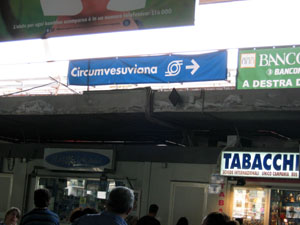
Circumvesuviana Sign Med Lrg |
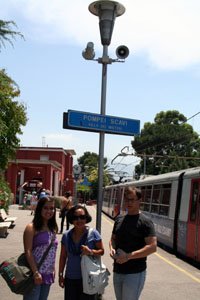
Pompei Scavi Station Med Lrg |
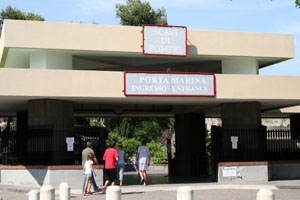
Porta Marina Entrance Med Lrg |

Porta Marina Area MP4-Sml MP4-Med WMV-HD |
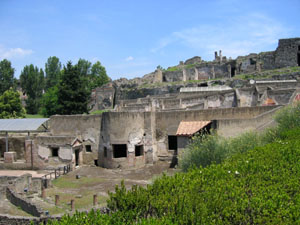
Outside the City Wall Med Lrg |
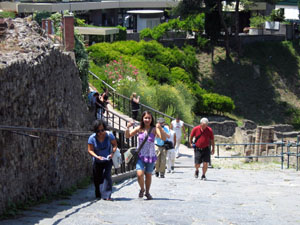
Climbing the Hill Med Lrg |

Approaching the Gate Med Lrg |
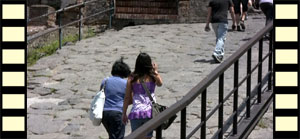
Entering the Gate MP4-Sml MP4-Med WMV-HD |
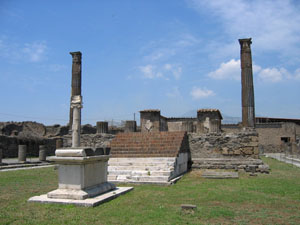
The Temple of Apollo Med Lrg |
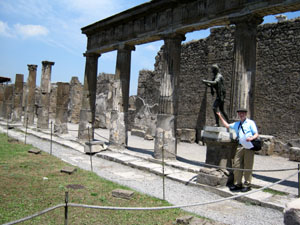
Colonnade and Statue of Apollo Med Lrg |

Nella and Forum Area Med Lrg |

The Temple of Jupiter Med Lrg |
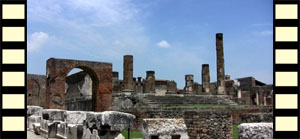
Forum and Storage Area MP4-Sml MP4-Med WMV-HD |
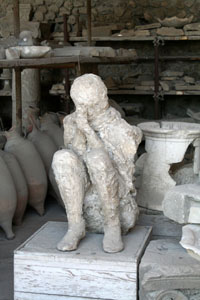
Eruption Victim Med Lrg |
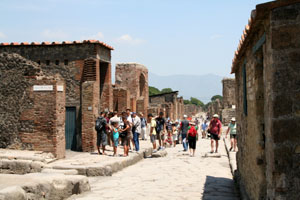
Via delle Terme Med Lrg |
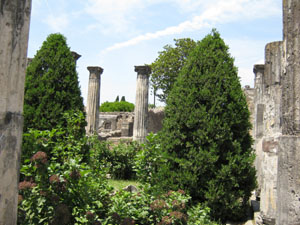
Columns, Casa di Pansa Med Lrg |

Calidarium, the Forum Baths Med Lrg |
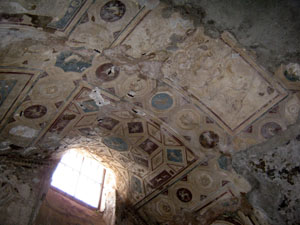
Tepidarium, the Forum Baths Med Lrg |
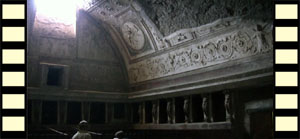
The Forum Baths MP4-Sml MP4-Med WMV-HD |

The Temple of Fortuna Augusta Med Lrg |
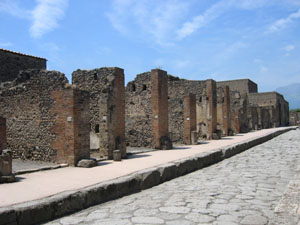
Residential Area Med Lrg |
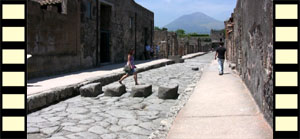
Connie Crossing the Street MP4-Sml MP4-Med WMV-HD |

House of the Small Fountain MP4-Sml MP4-Med WMV-HD |
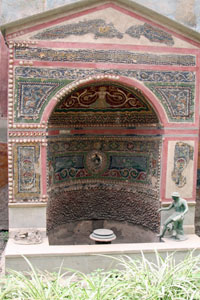
The Small Fountain Med Lrg |
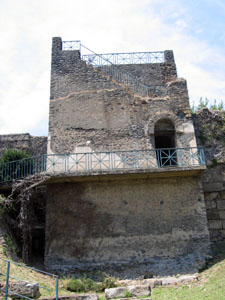
Torre di Mercurio, North Wall Med Lrg |
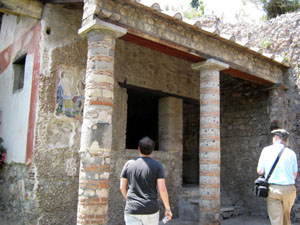
The House of Apollo Med Lrg |
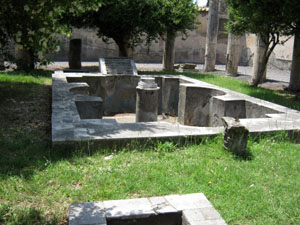
Large Pool Med Lrg |

The Forum Area Med Lrg |
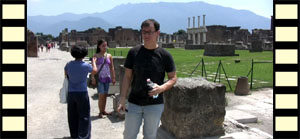
The Forum Area MP4-Sml MP4-Med WMV-HD |
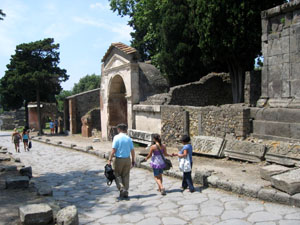
Via dei Sepolcri Med Lrg |
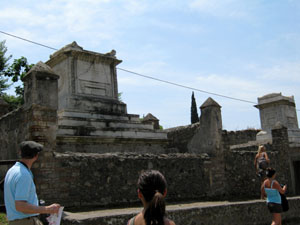
Massive Tomb Med Lrg |
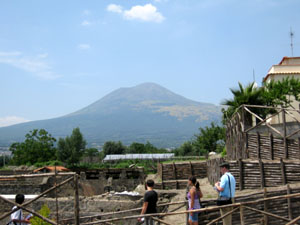
Mt. Vesuvius Med Lrg |
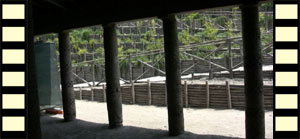
In the Villa of Mysteries MP4-Sml MP4-Med WMV-HD |

Connie and Bob with Tree, Villa of Mysteries Med Lrg |
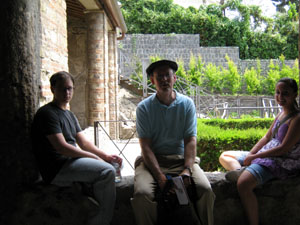
Tourist Tableau - Philip, Bob and Connie Med Lrg |

Approaching Herculaneum Gate MP4-Sml MP4-Med WMV-HD |

Forum Area and Mt. Vesuvius Med Lrg |
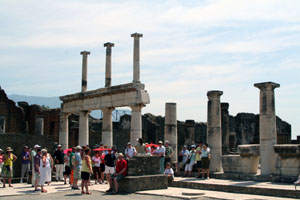
Colonnade and Tour Group Med Lrg |
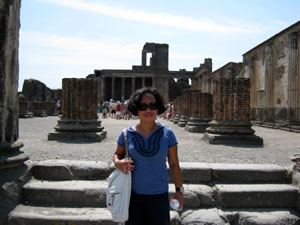
Nella and Basilica Med Lrg |
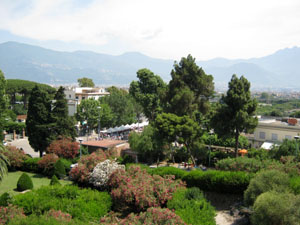
Modern Pompeii Med Lrg |

Concessions Near Entrance Med Lrg |

Nella and Giant Lemons Med Lrg |
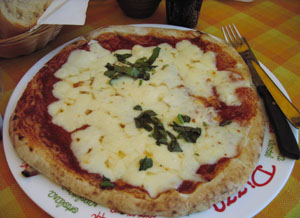
Philip's Pizza Margherita Med Lrg |

The Sorrento Train MP4-Sml MP4-Med WMV-HD |

